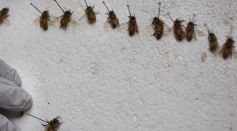ENVIRONMENT & CLIMATE

Cooler, Longer-Lasting Solar Tech Could Increase Yearly Production of Energy

Paleozoic "Living Fossil" Still Thriving on Ocean Floor After Being Missing for 270 Million Years

Uncooked Rice May Contain Harmful Microplastics, Sparking Health Fears to Millions of Consumers

Bunny "The Talking Dog": Self-Aware Canine Asks About the Meaning of Life
Iceland's Volcano Spews Lava Geysers High Into the Air, Thrill Seekers Left in Awe

Remains of 9 Neanderthals Found Near Rome, Offering Insights on Prehistoric Population

Comprehensive Genome Analysis Reveals Four Known Species of Giraffes
Probiotic Bacteria May Help Corals Endure Heat Stress, Bleaching

Modern Human Lifestyle a "Perfect Storm" for Pandemics Like COVID

Trained Bees Detect Coronavirus? Scientists Use These Insects to Identify COVID-19 Through Smell

Frog-Faced Turtle Endemic in Madagascar Unearthed After 100 Million Years, Reptile Sucks Down Its Prey!
Sharks Use Earth's Magnetic Field as Compass to Travel 12,000 Miles Across Sea
Mount Sinabung Eruption: People Warned of Volcanic Ashfall; What are Its Effect on Human Health?
Pint-Sized Dinosaur from Mongolia Has Eye Vision Like an Owl at Night
Most Popular

Microplastics Are Everywhere — How Plastic Pollution Threatens Wildlife, Soil, and Water

Brain Health Aging Guide: Effective Strategies for Cognitive Decline Prevention and Lower Dementia Risk

Mitochondrial Health and Aging: How Cell Energy Drives Modern Anti-Aging Science

How Scientists Use Radio Telescopes to Search for Alien Signals Across the Universe





